Jun 18, 2018 | wedding planning

The most traditional of traditional guest books.
Are you planning to have a guest book at your upcoming wedding? There is no right answer to this question! It is one to consider, though, if you are coming up on the wedding soon.
I’ve seen some things online saying that the guest book used to be a legal document for all the witnesses to the wedding. But I have not seen any references for that statement, so I don’t know whether or not it is true. I would imagine that one traditional use of the wedding guest book would be if your entire church congregation is invited to the wedding, then a guest book would tell you who actually showed up. (It used to be more commonly the case that the reception following a church wedding would have a separate invitation, and not everyone was invited to both.)
The way most people do weddings these days, that would not be necessary, as the couple generally has a very good idea of who is coming and who actually shows up. So, then, what is the point of the guest book?
The way it has evolved, the guest book is now often a wonderful way for guests to write a note to the couple. The traditional, lined guest book (like the one at the head of this article) is not conducive to creativity, but a blank book (or other place for people to express themselves) often brings out heart-felt sentiments from the guests. There are plenty of other options, as well.
A creative couple I worked with a few years ago had this for their guest book:
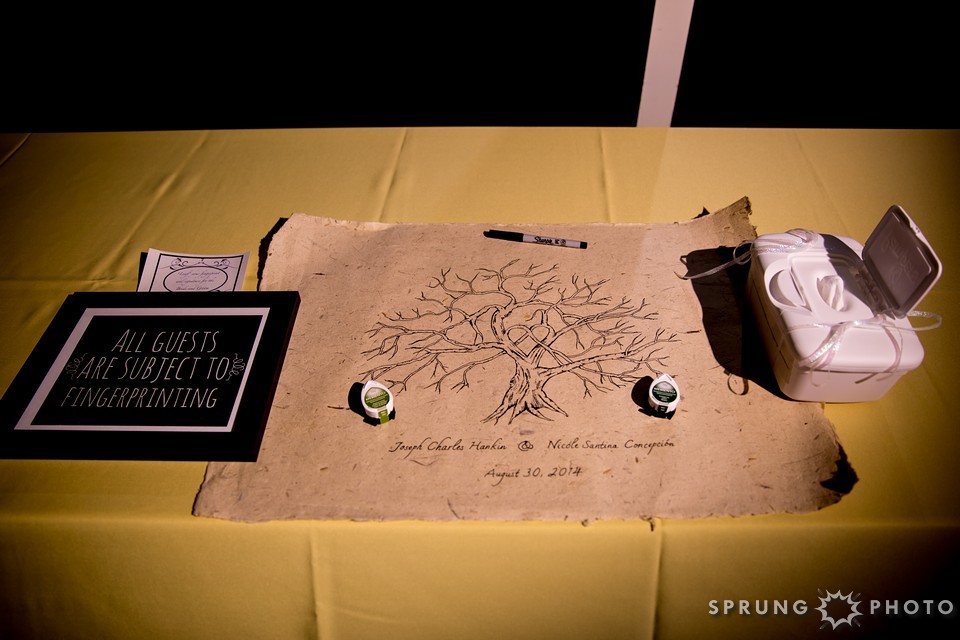 In case you can’t see what it is, it’s a drawing of a tree, with ink pads on it. The sign reads, “All guests are subject to fingerprinting.” The guests’ finger- and thumb-prints were added as the leaves on the drawing of the tree. There is also a pen there for guests to write their well-wishes.
In case you can’t see what it is, it’s a drawing of a tree, with ink pads on it. The sign reads, “All guests are subject to fingerprinting.” The guests’ finger- and thumb-prints were added as the leaves on the drawing of the tree. There is also a pen there for guests to write their well-wishes.
One of my very favorite recent guest books was at the wedding of a couple of scientists. Here was their guest book:
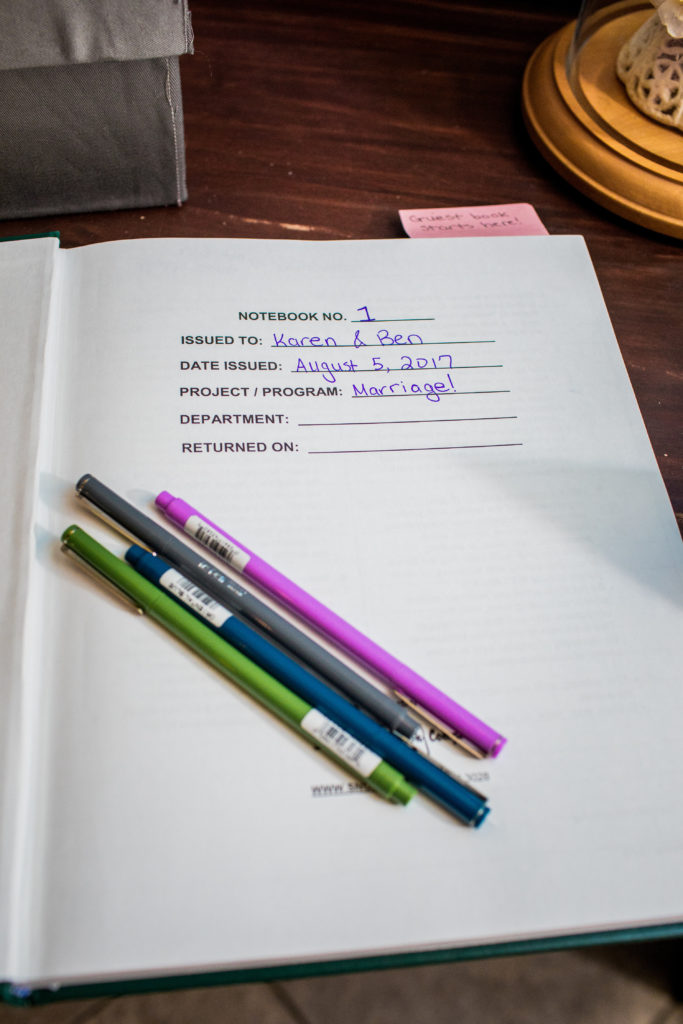
Photo by Allison Williams Photography.
Yes, that’s right: They used a lab book for their wedding guest book! And here is an example of how their guests used it:
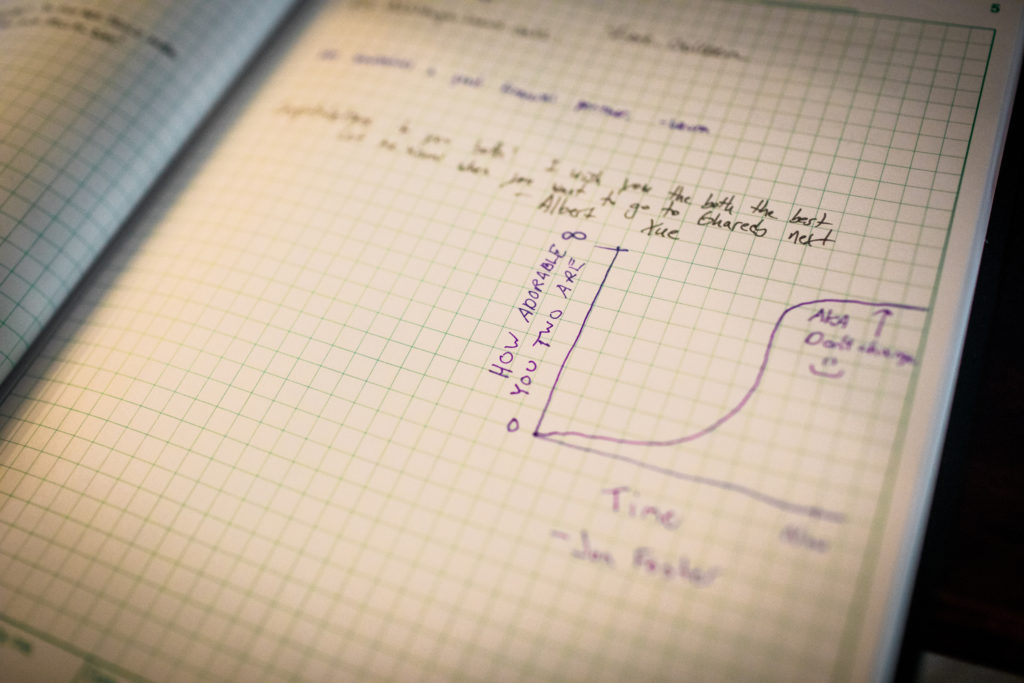
Photo by Allison Williams Photography.
Of course, if you’re a traditionalist, there is nothing wrong with having a good, old-fashioned guest book.
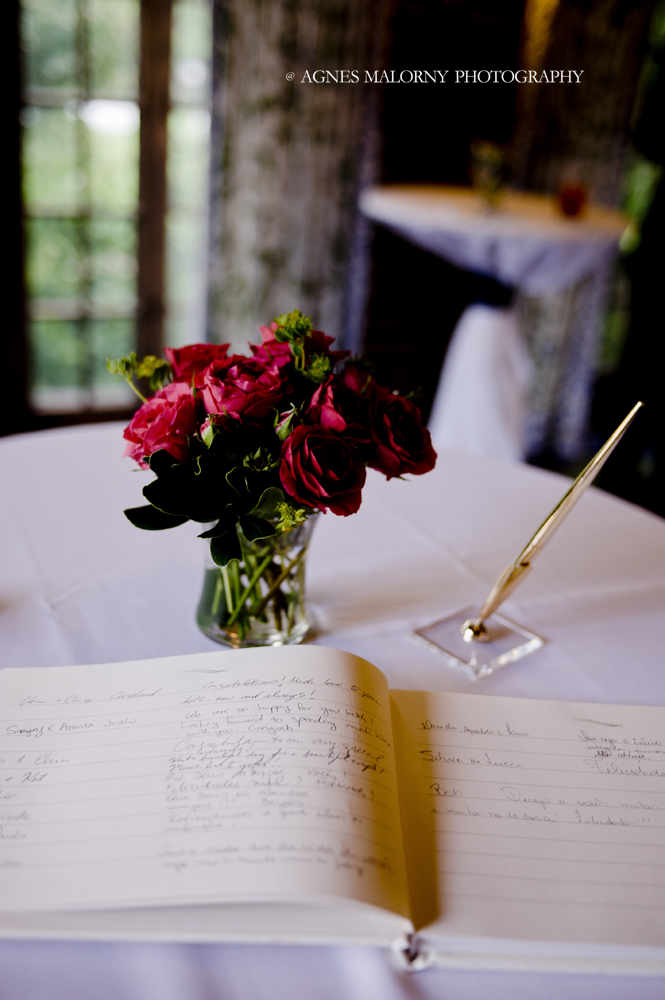
Jun 4, 2018 | wedding planning
I think my services must appeal to introverts as I seem to have a lot of clients who identify themselves that way. It makes sense: I am one, too. And I got married once, so I had an introvert wedding, and I understand some of the hurdles on the way to your introvert wedding.
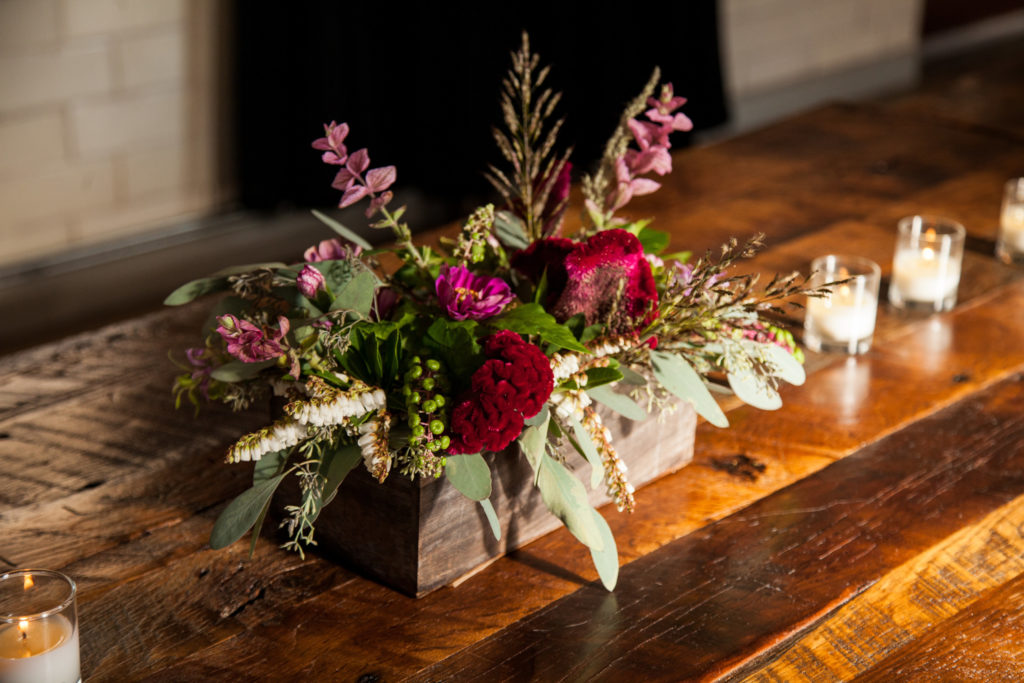
Introvert weddings can look just like extravert ones! (Photo courtesy of Cage+Aquarium. Flowers by May Floral.)
For those of you who are not introverts, perhaps a few definitions are in order. An introvert is not (necessarily) a shy person or an anti-social person. According to the Urban Dictionary, an introvert is “One who focuses on the inner world of thoughts and ideas.” A second definition is, “One who gains energy from alone time, one who thinks before they speak.” (Same source. Not my run-on sentence.)
In case it’s not obvious from the definition, there can be some definite difficulties for introverts getting married. A lot of us don’t care for being the center of attention. Crowds of people, even people we love, can be exhausting. Even things like being photographed are not always pleasant.
So, how do you navigate the difficulties inherent in such a public display as a wedding if you’re an introvert? I would say that the number one thing is to hire people to work on your wedding who understand your point of view and what you want–and who are willing to do what it takes to make your wedding live up to your vision for it. That doesn’t mean hiring all introverts, but it might mean taking the time to thoroughly interview all your wedding vendors to make sure they are sympathetic to your way of thinking, and trusting your gut when it comes to deciding on them. I’m also obligated at this point to mention that hiring a planner who understands your needs will get you access to other vendors with a similar point of view.
Two other things to think about are the size and the style of your wedding. If you can have a smaller wedding without offending friends and family (or if you don’t care!), it will likely be less stressful. And often a more casual wedding will be easier than a more formal one.
In the end, as with all weddings, it is up to you to decide how you want to get married and celebrate. If that means eloping and telling the family later, then that’s what you can do. If a more structured event is still something you want, just remember that you can still make the choices to make it work for you. There is no one right way to get married. There is only the way that is right for you.
May 28, 2018 | wedding planning
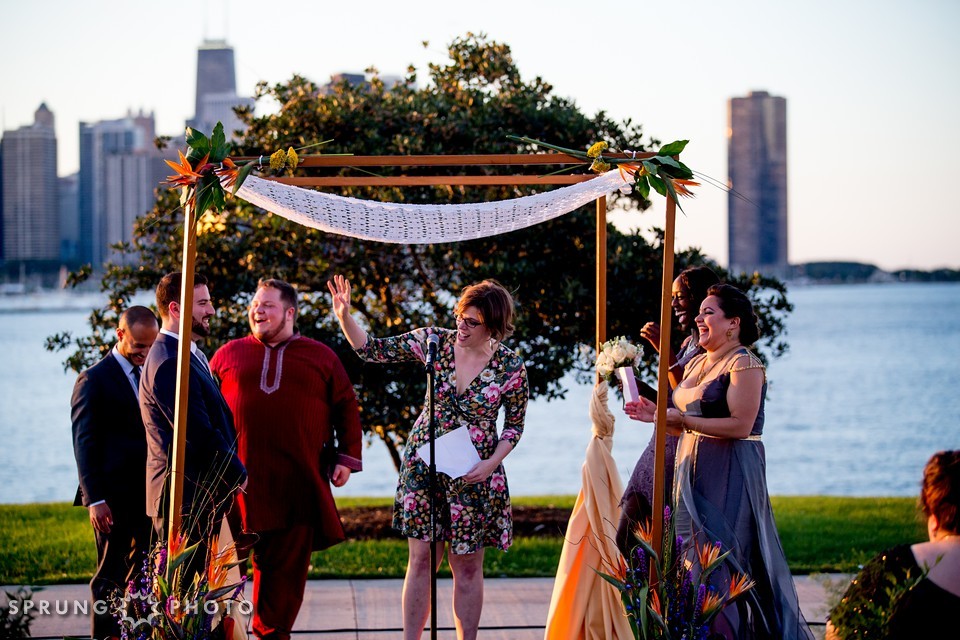
Sometimes, the unscripted moments in a wedding are the most memorable. (Photo courtesy of Sprung Photo.)
I have a confession to make: I didn’t actually watch the whole Royal Wedding last week. I’ve seen bits and pieces of it, and I will say that it looks quite impressive. And from talking with other planners, one of the things that seems to have been outstanding was how smoothly everything flowed.
Now, as you probably know if you know anything at all about me, I have a long history in the world of performance as a stage manager. So, I started thinking about all the things they probably had to do to make the whole event go off so evenly. I am guessing that they had hours of rehearsal with every single participant and huge teams of event/stage managers who wrangled people into place and made sure that everyone was right on their mark. (They probably even had rehearsals for the TV cameras, because that would be necessary, also.)
I hear people saying that this wedding has set a new standard for weddings and it is going to influence all of the style trends. I’ve even heard a planner say she is going to study it to improve her skills in stage management to make her weddings go off like that one did. I’m all in favor of self-improvement, but that makes me wonder: Is the performance element of a wedding really the important thing?
Don’t get me wrong: There is always an element of performance in any ritual created by humans. It seems to be part and parcel of how we do things. (Don’t forget that live theatre started out in ancient Greece as a religious ritual!) Weddings are inherently performative to a certain degree, to the everlasting discomfort of engaged introverts everywhere.
But is the performance element the most important thing? I would argue that it is not. In fact, my contention is that it is the least important thing about a wedding. Making a good spectacle should be near the bottom of the list of concerns. Up at the top of the list, I would put the content or the heart and the meaning of the day. Weddings are about a lot of different things (family, community, love, economics, religion, and, yes, spectacle), but I think that they ought to focus on the people who are getting married and on the project of marriage that they are embarking upon together.
And this is why I tell my clients not to stress about whether or not their wedding day goes like a made-for-TV movie. Yes, the goal is for everything to go off without a hitch, and I always have one eye on creating appropriately dramatic moments, but if there are delays or less-than-perfect performances or even outright mistakes at your wedding, as long as you end up married to the right person at the end of the day, that is all that really matters.
May 21, 2018 | wedding planning
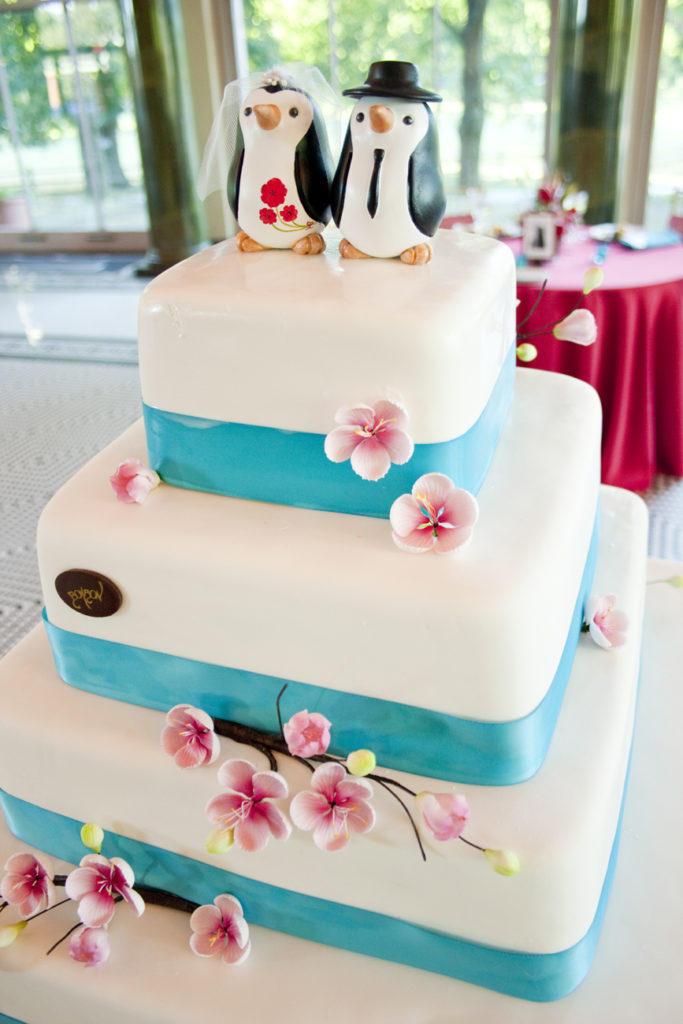
How many other great ideas were ruled out to get to this fun and whimsical design choice? (Photo by hannahelaine photography (hannahelaine.com).)
Just in case you’re at this point in your planning process, here’s my advice on making choices for your wedding:
I wrote before about ways to approach decision-making for your wedding. This topic comes up frequently in my conversations with clients. Frequently, I am hearing things like, “There are so many choices, I don’t know how to make a decision” or “I love Pinterest, but when I spend time on it, it makes it harder for me to know what I want.” I also hear (a lot), “The process of wedding planning is really overwhelming!”
If this is how you feel, you should know that you’re not alone. It’s great to have a lot of choices and wonderful to have access to all sorts of ideas when you’re planning a wedding (or any other event). Being able to see what other people have done successfully is a great resource. Borrowing ideas can spark your own creativity. But once you have amassed all these ideas, what is the next step? I think this is where many people have trouble.
I’m lucky that I’ve spent several decades working with many wonderfully creative people in the live theatre industry. I’ve learned a lot from the various designers and directors and other artists about how the creative design process works. I’m not going to even try to distill it into a brief how-to manual (because I’m pretty sure that’s impossible), but here are a few ideas.
A design board (also called an inspiration board or a vision board) is a way to collect the best visual ideas you have in one place and to see if they will all work together. (There are lots of DIY tips online for how to do this. It’s also one of the things you can do in Pinterest.) What you may discover is that you have a few too many great ideas–which leads directly to my next tip:
You will probably have to discard some of your ideas. You may have to discard a lot of your ideas. The best events (like the best artistic creations) are focused and coherent. Simplicity can be your very best friend.
So, how do you take all those ideas and revise them until you have a focused idea? Try putting your favorites at the top of your design board and put the ones you don’t love quite as much farther down. Keep re-arranging them until you are happy with the order. Now, can you remove any of the ones at the bottom? Because you are now at the point where you will probably have to get rid of some things. And if you can’t quite bring yourself to remove something, that might be a sign that it needs to be a little higher in the priority list. Re-arrange again and try removing some things. Eventually, you should be able to refine your design choices.
Here’s another way to pare down the choices: Pick two colors and two other things you like (a texture, a pattern, a shape, etc., depending on how you have approached your search for materials) and put all the ideas that fit within those parameters on one design board. Then try a different set of choices on a second board–and maybe one more after that. See what you like best. See what works best for you. If you like one set of ideas, you now have a narrower set of choices to work with.
And here’s one more idea: Hire a professional to work with you if you find the entire process too much for you. Wedding planners are very good at narrowing down the field based on your preferences and can help you to focus your search for venues and vendors and to guide your design process. There are a lot of decisions to be made as you plan a large event like a wedding. It helps to have a guide who has done this before.
May 14, 2018 | Accessibility, wedding planning

Consider the needs of everyone at your party. (Photo by Peter Coombs.)
I’ve been thinking a lot about accessibility lately: How is the world accessible for some people and not for others? What can we do to make it more accessible for everyone? Even weddings and other happy occasions need some attention to make sure that everyone who is invited can get there and then enjoy themselves.
The most obvious kind of accessibility–the one that comes to everyone’s mind first–is mobility accessibility. Does your venue have flights of stairs it is necessary to navigate in order to get to where the events are? Are there elevators or ramps that allow people with wheels to get there? You might also want to notice if there is a lot of walking involved, since some people can’t walk long distances. Sometimes even the walking surface can be an issue. I worked on a wedding where the matron of honor was able to walk on smooth surfaces without a problem, but she had difficulty crossing a stretch of grass to get to where the ceremony was. These are all things to think about when you are choosing your venue, or deciding what parts of it to use.
Mobility limitations are not the only kinds of disability you can think about when making decisions about your wedding or event. Are there people who don’t tolerate noisy environments well? (Consider both people who have hearing loss and neurodivergent people, for starters.) What can you do to make sure everyone is comfortable with the noise levels? What about lighting levels? People with limited vision might appreciate having enough light to see by.
I’ve noticed a trend toward weddings that don’t have assigned seats for a formal, sit-down dinner. If this is your plan, you’ll probably want to make sure that there are dedicated seats for the people who can’t stand up for long periods of time.
I’m only scratching the surface here thinking about accessibility in weddings and parties. When you consider your guest list, you may think of many other ways you can be considerate to your guests by making your event accessible to them. Perhaps the most important thing you can do is to let your guests know that you want them to tell you if they have specific needs. Even if you can’t solve all their problems, you can do your best to make sure they have a good time.
Jan 15, 2018 | wedding planning

A sample from last year’s show. Photo by Genevieve Lauren Photography.
Okay, this is it! The Green Wedding Alliance’s annual wedding show, Committed, is coming right up on Sunday, January 21. That’s next Sunday! Don’t wait. Buy your tickets now.
The show is from noon to 3:00 p.m. at Greenhouse Loft, 2545 West Diversey Ave. 2nd Floor.
And why should you buy a ticket today and go on Sunday? I’ll tell you! Committed is a mellow gathering of the multi-talented vendors belonging to the Green Wedding Alliance. Every vendor is committed not only to high quality service to couples getting married, but also to the principles of environmental sustainability. It’s a win for everyone.
So, if you’re committed to someone and looking for a terrific collection of wedding vendors, check out Committed. There will be food and beverages to sample; photographers’ work to admire; florists and bakers with their wares; music and maybe even dancing. Bring your partner or a friend or your mom and enjoy an afternoon exploring wedding vendor possibilities. Get your tickets today!
 In case you can’t see what it is, it’s a drawing of a tree, with ink pads on it. The sign reads, “All guests are subject to fingerprinting.” The guests’ finger- and thumb-prints were added as the leaves on the drawing of the tree. There is also a pen there for guests to write their well-wishes.
In case you can’t see what it is, it’s a drawing of a tree, with ink pads on it. The sign reads, “All guests are subject to fingerprinting.” The guests’ finger- and thumb-prints were added as the leaves on the drawing of the tree. There is also a pen there for guests to write their well-wishes.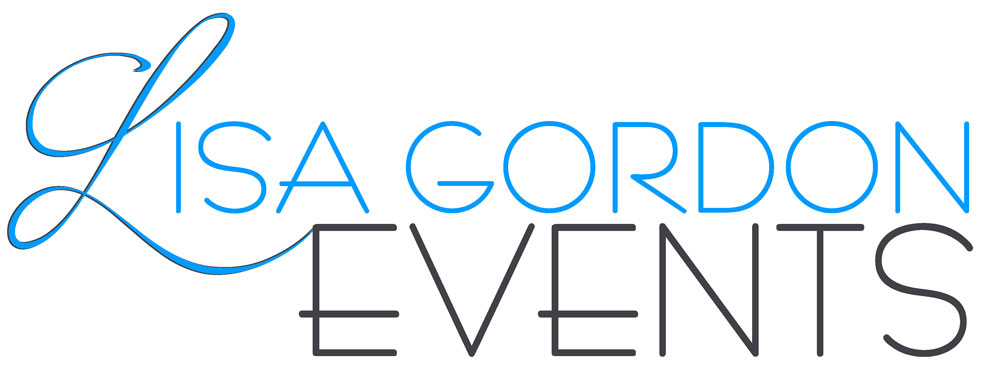









Recent Comments